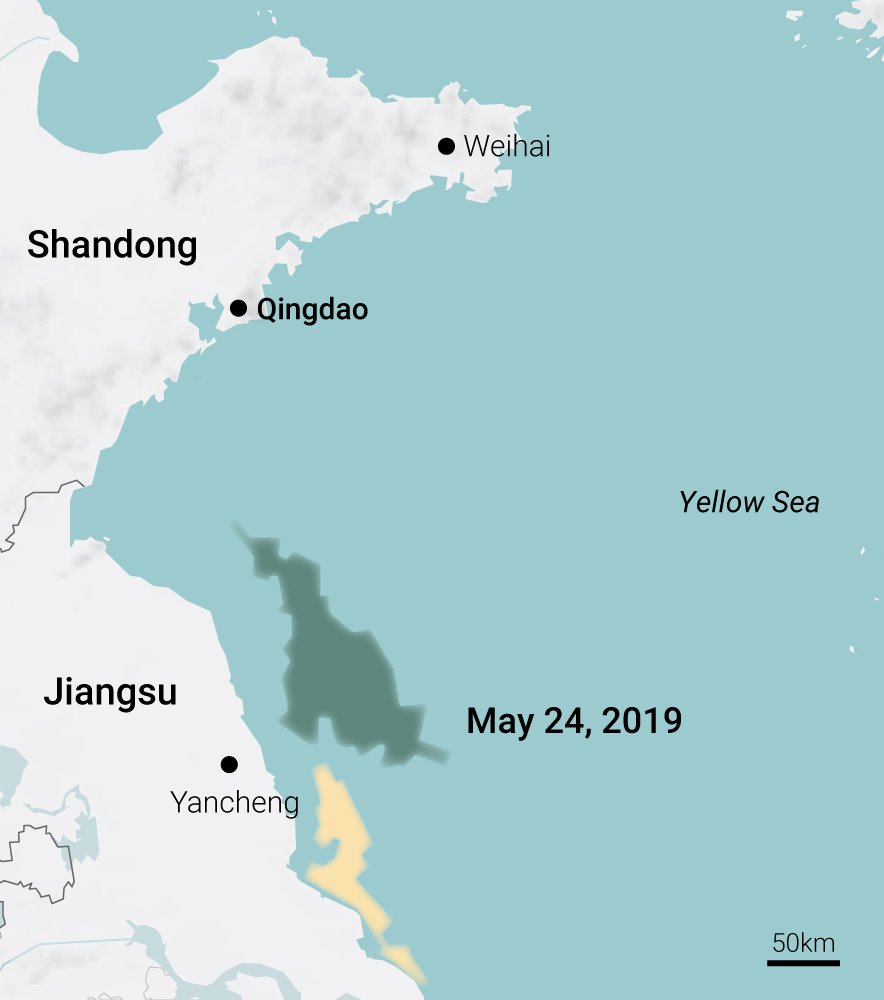Record algae bloom swamps China’s port city of Qingdao
China’s eastern port city Qingdao in Shandong province is suffering its worst ever algae infestation. Often regarded as one of the most beautiful and clean cities in China, the algae bloom has overwhelmed the city’s normally golden beaches so that they now resemble sprawling grasslands.
The green algae, or hutai as the Chinese call it, has inundated the sea waters off Shandong province every summer for the past 15 years, lasting about three to four months each time. In 2008, Beijing spent more than US$100 million on a massive clean-up as the city prepared to host sailing events at the Beijing Olympics.
NASA OceanColor Webmaster, June 19, 2021
The algae
Ulva prolifera is a species of seaweed that can be found worldwide. While it is not toxic to humans or animals and has great nutritional value when eaten, it can choke off oxygen supplies for marine life and emit foul odours. This does little to attract tourists to a city long famed for its beaches and locally brewed Tsingtao beer.

Worst algae bloom
On June 26, the outbreak ran riot over an unprecedented 60,594 sq km and fully covered 1746 sq km, more than double the size of the fully algae-covered area in 2013, the second worst year recorded. According to the Qingdao Ocean and Fishery Bureau, the local government has deployed 12,686 vessels to collect the algae, and more than 457,700 tonnes have already been cleaned from the water. According to state owned media, the amount of algae collected could top 1 million tonnes.
Largest affected areas since 2008
(In thousand square kilometres)
Source: Bulletin of China Marine Disaster in 2020
Natural environment
The massive algae bloom usually forms in the Yellow Sea about 300km south of Qingdao from mid-April to early May, moving north and northeastward in June and July, and then disappears in mid or late August. Ulva prolifera generally grows well at temperature ranges of 15–25 degrees Celsius. When the seawater, salinity and sunlight are favourable, the small-scale floating algae expand rapidly. The longest lasting invasion of Ulva prolifera recorded was more than four months in 2019.
Sea surface temperature during 2019 algae blooming period
Source: NASA Earth Observations
Seaweed farming
Although the cause of the bloom remains something of a mystery, several scientists believe the algae grows on rafts used by seaweed farmers in Jiangsu province – to the south of Shandong province – to grow porphyra, an edible species of seaweed popular in Japan. When the seaweed is harvested in April, any Ulva prolifera that has grown on the rafts is discarded and swept into the sea by waves.

Sources: National Marine Environmental Forecasting Center; Key Laboratory of Research on Marine Hazards Forecasting, Ministry of Natural Resources of the People’s Republic of China
The dead zone
The algae blooms, along with other factors such as river contamination due to agricultural fertilisers, can cause “hypoxia” in the deep water, meaning that the oxygen levels become so low that most marine life either dies or leaves the area. This is called a “dead zone”.
Official statistics from the China Fishery Yearbook show that seaweed farming in Jiangsu expanded from 29,751 acres in 2004 to 102,961 acres in 2019. In addition, as the largest shrimp and crab cultivation zone in China, more than 50,000 tonnes of fertilisers, which contain nitrogen and phosphorus, are poured into the ponds yearly.
Yellow Sea habitation
The Yellow Sea once hosted some of China’s most productive fishing grounds. But today, due to industrial pollution and oil spills, they are among the most degraded marine areas on earth.
Water quality of rivers entering China’s seas
Source: Bulletin of Marine Ecology and Environment Status of China in 2020
As reported by WWF, 276 species of fish and 173 species of water birds inhabit China’s Yellow Sea Marine Ecoregion.
Here are some of the more common marine species found in the waters.
The algae bloom is not only an ecological problem but also highly political. Jiangsu province flatly rejects that the origin of Ulva prolifera is due to the tens of thousands of hectares of tidal flats their farmers devote to growing seaweed. The mass clean-up movement every summer exacts a heavy price for Qingdao, which spent about US$15.4 million in 2016 alone.
Creative Director Darren Long
Illustration by Adolfo Arranz
Edited by Melissa Zhu
Sources: NASA; Ministry of Ecology and Environment of the People’s Republic of China; Monitoring seaweed aquaculture in the Yellow Sea with multiple sensors for managing the disaster of macroalgal blooms: Xing Qianguo, An Deyu, Zheng Xiangyang, Wei Zhenning, Wang Xinhua, Lin Li, Tian Liqiao and Jun Chen; Numerical simulation and forecasting of drift, growth, and death of enteromorpha in the Yellow Sea: He Enye, Ji Xuanliang, Gao Shan,Zhao Liang, Wang Yuheng, Li Yun, Yang Jing